Getting a prosthetic limb is not just about replacing what’s lost—it’s about regaining the freedom to move, live, and feel like yourself again. But what happens when that process is delayed? For many, it may seem like waiting a few extra weeks or months won’t make a big difference. Unfortunately, that’s not true. In fact, postponing prosthetic fitting can deeply affect how a person walks, moves, and lives in the long run.
This article takes a deep dive into the connection between delayed prosthetic fitting and long-term gait issues. We’ll explore how timing can make or break recovery, and why early fitting is one of the smartest decisions a person can make after amputation.
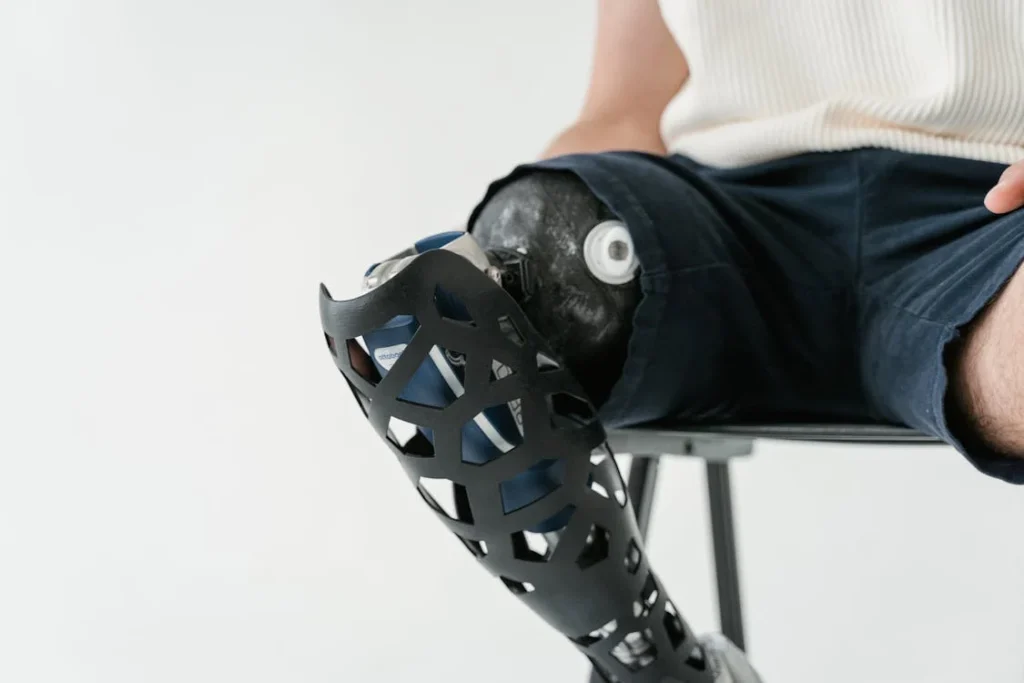
Understanding Gait: Why It Matters After Amputation
What is Gait and Why Is It So Important?
Gait simply means the way a person walks. But it’s more than just putting one foot in front of the other. A healthy gait involves smooth, balanced, and natural movement of the whole body.
From the way your hips sway, to how your arms swing, to how your feet land on the ground—it all comes together to form your unique walking style.
After an amputation, especially of a lower limb, gait is disrupted. Your body suddenly loses part of the structure it relies on for balance and support. This throws off your center of gravity, which can affect how you stand, walk, and even how you sit or lie down.
That’s where a prosthetic comes in—it helps restore this balance and support. But when there’s a delay in getting the prosthetic, your body starts to adapt on its own in ways that may not be healthy.
Without proper support, your body creates compensations—altered movement patterns to stay upright and mobile. These patterns may work short-term, but they often cause long-term strain on joints, muscles, and bones.
Over time, these poor patterns become habits, making it much harder to return to a natural gait once the prosthetic is finally fitted.
What Happens to the Body During a Delay in Prosthetic Fitting?
Muscle Weakness and Imbalance
When someone loses a limb and doesn’t get a prosthetic quickly, the muscles that used to work in harmony begin to weaken. Imagine a team where one player is missing, and the others try to cover the role.
Eventually, they get tired. This is what happens inside the body—some muscles overwork, others get lazy, and the balance breaks down.
For example, the hip and core muscles of the amputated side often weaken without the challenge of daily movement. The remaining leg, on the other hand, starts doing extra work. This imbalance grows with time, leading to pain, tightness, and difficulty walking.
Joint Stiffness and Contractures
Delays also increase the risk of joint stiffness. Without regular motion and weight-bearing, joints start to tighten up. For lower-limb amputees, knee and hip joints are especially at risk. The longer they stay inactive, the harder it is to regain full range of motion.
In severe cases, this leads to contractures—when a joint becomes permanently stuck in a bent position. A contracture makes prosthetic fitting much more difficult and often limits the type of prosthetic you can use. It can also make walking nearly impossible.
Poor Posture and Spinal Stress
The body is smart—it will do whatever it can to keep you upright. But smart doesn’t always mean healthy. When the prosthetic is delayed, amputees often rely heavily on the remaining limb and their upper body.
This causes a shift in posture. Shoulders hunch forward, the back curves more, and the spine gets overloaded with uneven stress.
Over time, this unnatural alignment can cause chronic pain in the lower back, neck, and shoulders. It also reduces overall energy levels, since walking with poor posture takes more effort.
Psychological Toll That Affects Physical Movement
The Mind-Body Connection
Walking is not just a physical act—it’s also deeply emotional. Many amputees feel vulnerable, anxious, or even embarrassed about their changed mobility. If the prosthetic fitting is delayed, these emotions often grow.
Fear of falling or being seen as “different” can lead to less movement. This reduced activity further weakens the body and delays recovery.
Moreover, when a person doesn’t have access to their prosthesis, they may start losing confidence. Each missed step becomes a reminder of what’s been lost rather than a step toward independence. Confidence is a powerful fuel for recovery—and delays drain that fuel fast.
Behavioral Adaptations That Become Permanent
People naturally start to adapt to life without the prosthetic. They may use crutches, wheelchairs, or walkers. These devices are helpful for short periods but not meant for long-term use.
Unfortunately, when someone gets used to them, they may avoid using their prosthetic even after they receive it.
This behavior further prevents the body from learning how to walk correctly with the new limb. The longer someone stays away from natural movement, the harder it becomes to relearn it. Gait problems, at this point, are not just physical—they’re embedded in the brain.
How Delayed Fitting Affects Prosthetic Training
Slower Progress and Frustration
Prosthetic training usually involves working with a physiotherapist to learn how to balance, walk, climb stairs, and move confidently. This training is much more effective when started early.
When fitting is delayed, patients arrive at therapy with muscle loss, joint tightness, and deeply rooted compensations. As a result, progress is slower.
Each session takes more effort and produces fewer results. This can be frustrating for both the patient and the therapist. Motivation may dip, and some patients may give up altogether. The longer the delay, the steeper the climb back to mobility.
Fewer Options for Prosthetic Types
When the body has changed due to delays—stiff joints, weak muscles, or poor posture—it limits what kind of prosthetic can be fitted.
Some advanced prosthetics need a certain level of muscle control or limb flexibility to work well. If those conditions aren’t met, the patient may have to settle for a simpler device.
This doesn’t just affect movement—it affects quality of life. An advanced prosthetic can help someone run, swim, or cycle. A basic one may only allow slow, flat-surface walking. That’s a huge difference in lifestyle, and it all ties back to how early the fitting began.
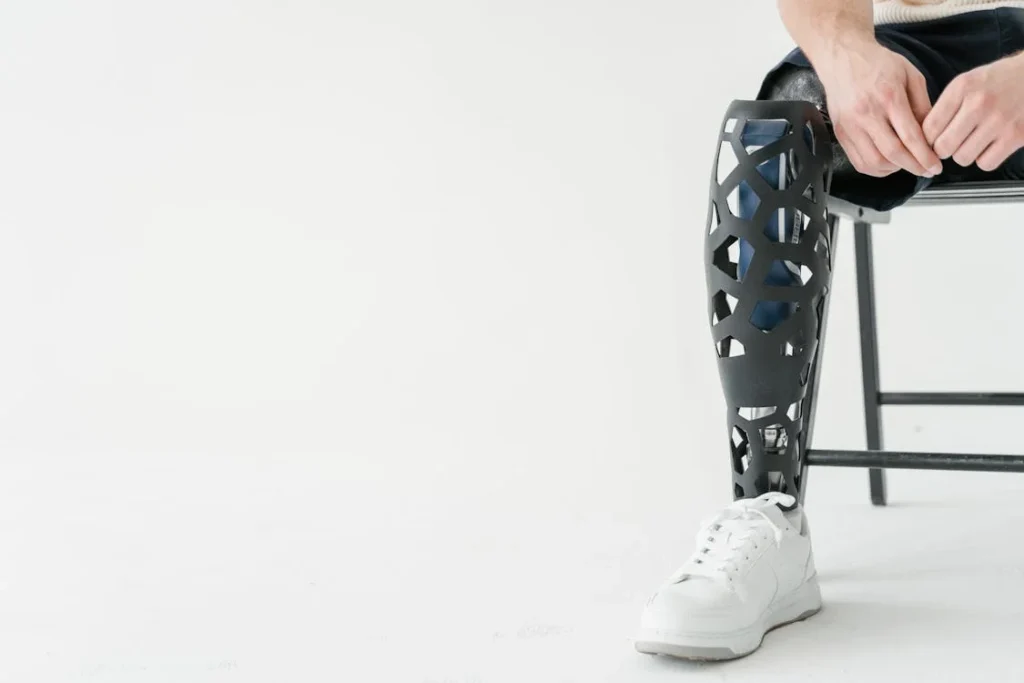
Why Early Fitting Makes All the Difference
Muscle Memory Works in Your Favor
When a prosthetic is fitted early, the brain and body work together to adapt quickly. Muscle memory is still fresh. The muscles haven’t yet developed harmful compensations.
The brain is still open to learning the new walking pattern. This makes training smoother, more effective, and much less tiring.
Every step taken with the prosthetic helps reinforce a good gait. Over time, this becomes natural. The body starts to move in a balanced and fluid way again. All of this becomes much harder when fitting is delayed.
Boost in Confidence and Motivation
Receiving a prosthetic early is a huge psychological boost. It shifts focus from what’s lost to what’s possible. It also helps people get back to their daily routines faster—whether it’s cooking, working, or simply walking around the house.
This sense of progress keeps people motivated. They show up to therapy. They try harder. They believe in their recovery. And all of this translates into better outcomes and a lower risk of long-term gait problems.
Steps You Can Take to Avoid Long-Term Gait Issues
Don’t Wait for “Perfect Healing”
Many people delay prosthetic fitting because they believe they must wait until their residual limb is completely healed. While some healing is necessary, waiting too long can backfire.
Most modern prosthetic fittings work well even as the limb continues to heal and shrink in size. In fact, early fittings can help shape the limb and prevent future problems.
If you’re unsure, speak with a prosthetist early. They can guide you on when it’s safe to start the process. Often, temporary or preparatory prosthetics are used in the beginning, and then upgraded later.
Engage in Physical Therapy Immediately
Even before you receive a prosthetic, physical therapy can begin. Therapists can help you keep your joints flexible, strengthen key muscles, and maintain balance. This makes the transition to a prosthetic smoother. Skipping this step makes recovery much harder.
The earlier you start moving and training, the less your body will compensate in unhealthy ways. Think of therapy as building the foundation for walking again.
Stay Mentally Prepared
Mindset matters. If you’re focused on progress rather than pain, the road gets easier. Educate yourself. Ask questions. Talk to others who’ve gone through it. Stay involved in your care. Mental strength often translates into physical resilience.
By staying engaged and hopeful, you’ll be more likely to start and stick with your training—and less likely to face long-term problems.
The Role of Residual Limb Health in Gait Recovery
How Residual Limb Shape Affects Walking
One of the lesser-discussed but crucial aspects of post-amputation mobility is the shape and condition of the residual limb (also called the stump). When prosthetic fitting is delayed, the limb can change in ways that affect long-term gait—often for the worse.
Without early pressure from a temporary prosthesis or shrinker sock, the limb may swell or develop irregular shapes like bulbous ends or uneven contours.
These changes can make it harder to fit a socket properly. An ill-fitting socket causes discomfort and instability while walking, which contributes to limping, favoring one side, or hesitating during foot strike.
Even if the prosthesis is high-tech, a poor socket fit means the user won’t trust the limb. This lack of trust changes the entire gait cycle, as every step becomes cautious and unnatural.
Skin Problems and Pain That Disrupt Walking
Delayed fitting also means delayed skin conditioning. The skin on a residual limb needs time to adapt to pressure, friction, and movement within a socket. If this exposure doesn’t begin early, the skin remains sensitive and fragile.
When someone finally starts using a prosthetic after a long delay, they often face blisters, sores, or abrasions. These issues cause pain—and when walking hurts, gait automatically suffers.
Pain makes people shorten their steps, lean away from the prosthetic side, or avoid walking altogether.
By fitting a temporary prosthesis early, you allow the skin and limb to gradually build tolerance. This preparation lays the groundwork for a smooth gait transition.
Impact of Age and Timing: Why Older Adults Suffer More From Delays
Slower Healing and Muscle Recovery
Age plays a huge role in how the body reacts to both amputation and prosthetic delays. Older adults naturally heal more slowly. Their muscles also lose strength faster during periods of inactivity. This makes timely prosthetic fitting even more critical.
If an older person waits too long, the muscle loss may be so severe that walking again becomes very difficult, or even impossible without assistive devices. This leads to permanent changes in gait, such as using a walker, dragging the limb, or taking shuffling steps.
Higher Risk of Falls and Fractures
Delayed prosthetic use also increases the risk of falls—especially in older patients. Without proper weight-bearing and balance training, their posture and confidence decline.
Once a fall occurs, the injury (like a hip fracture) further delays recovery and reinforces fear-based movement patterns. These patterns often result in long-term gait impairments that are hard to reverse.
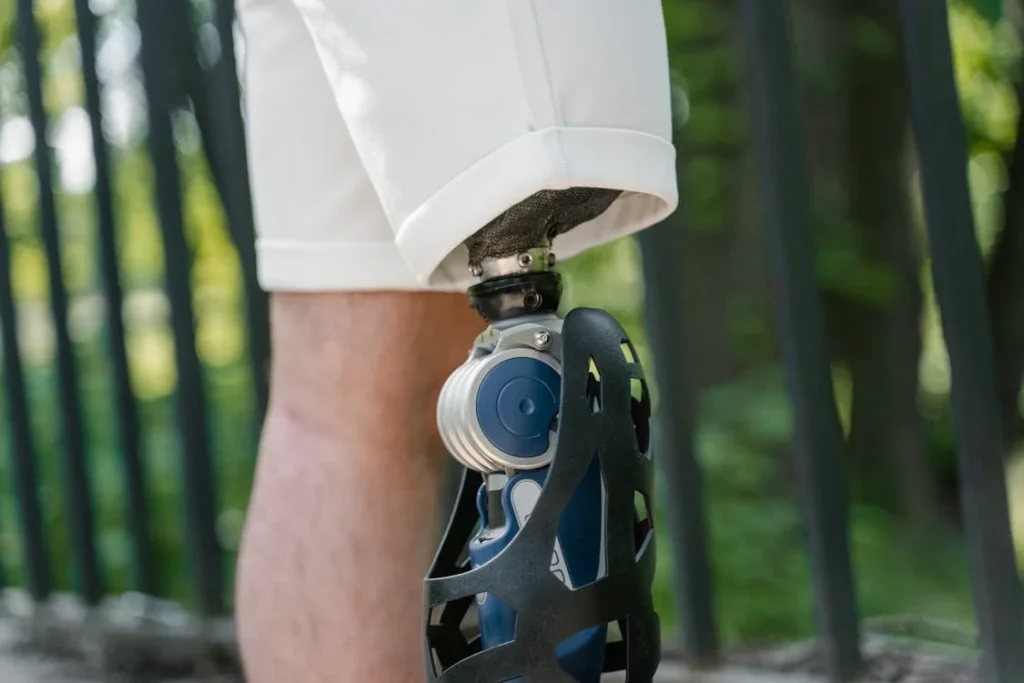
Children and Teens: How Delays Affect Developmental Gait
Missing the Window for Natural Growth
In young amputees, timing is everything. Children’s bodies grow rapidly, and their bones, joints, and muscles are in constant change. If a prosthetic is not fitted during key growth phases, it can affect the development of proper walking patterns forever.
Children who don’t get fitted early may grow up using unhealthy compensations. Their body might adapt with twisted hips, uneven shoulders, or even a curved spine (scoliosis). These issues are extremely difficult to correct later in life and can lead to lifelong gait dysfunction.
Psychosocial Impact on Movement Confidence
Children and teens are highly sensitive to how they’re perceived. If they go long without a prosthetic, they may start feeling isolated or “different.”
This affects their confidence in joining activities like sports or even simple play. A lack of early movement and social integration can indirectly impair gait by reducing activity and muscle use.
Early prosthetic use helps children feel included, mobile, and proud of their independence. This, in turn, encourages frequent and confident walking—which naturally develops proper gait patterns as they grow.
How Advanced Prosthetic Tech Can’t Undo Delayed Fitting Damage
Technology Isn’t a Magic Wand
Some people delay prosthetic fitting thinking they’ll wait for “the best” or “most advanced” device to become available. While it’s understandable to want the best possible solution, this delay often causes more harm than good.
Even the most advanced microprocessor knees or powered ankles can’t perform well if the body they’re attached to is weak, stiff, or out of balance.
The human body needs to be in decent shape to take full advantage of advanced prosthetics. Otherwise, the tech is underutilized and may feel clunky or uncomfortable.
Early fitting, even with a basic preparatory prosthetic, helps condition the body to accept and use advanced technology later. Skipping this early phase is like giving a Formula 1 car to someone who hasn’t yet learned to drive.
Wasted Costs and Poor Outcomes
Advanced prosthetics are expensive, and delayed users often get them with high expectations. But if their body isn’t ready, they may walk poorly or avoid using it entirely.
This leads to frustration, costly adjustments, or even abandonment of the device. Worse, insurers may be unwilling to fund a replacement if the first one was deemed a failure.
In contrast, early fitting builds the user’s capability over time. By the time they transition to advanced tech, their gait is already well-practiced and the device feels like a natural extension of their body.
The Role of Caregivers and Medical Teams in Avoiding Delay
Why Medical Guidance Is Often Misdirected
Sometimes, patients delay prosthetic fitting because their doctors focus only on surgical recovery or wound healing. While these are important, too many healthcare systems work in silos—surgeons do their part, and then the patient is left to figure out what comes next.
A strong interdisciplinary team that includes a prosthetist, physical therapist, occupational therapist, and psychologist can create a smoother, more proactive plan. They can introduce the idea of early fitting, temporary sockets, and early rehab before habits set in.
Unfortunately, in many parts of India and globally, this kind of integrated care is missing. That’s why patients and their families need to stay informed and push for early intervention themselves.
Caregiver Encouragement Can Make or Break Mobility
Family members play a huge role in how fast someone moves toward recovery. Encouragement, emotional support, and small nudges make a big difference.
When caregivers understand the dangers of delayed prosthetic fitting, they can motivate timely action—helping with appointments, therapy sessions, and moral support.
Waiting out of fear or uncertainty often backfires. But when loved ones are involved and well-informed, outcomes drastically improve, and gait issues can often be prevented entirely.
How Gait Issues Lead to Other Health Problems Over Time
The Domino Effect on the Whole Body
Walking poorly doesn’t just stay in the legs. It slowly affects everything. Long-term gait issues from delayed prosthetic use can lead to:
- Back pain from uneven hip motion
- Shoulder and neck strain from poor posture
- Arthritis in the non-amputated leg due to overuse
- Foot deformities on the healthy side due to altered weight distribution
These secondary issues often emerge months or years after the delay but can be much harder to treat than the initial gait problem.
Impact on Metabolism and Energy Levels
People who walk less naturally burn fewer calories. Over time, this leads to weight gain, reduced endurance, and even conditions like diabetes or high blood pressure. Delayed prosthetic use can slowly turn into a sedentary lifestyle—which then spirals into chronic health problems that are difficult to reverse.
Early fitting doesn’t just improve walking—it improves your ability to stay active, fit, and healthy overall.
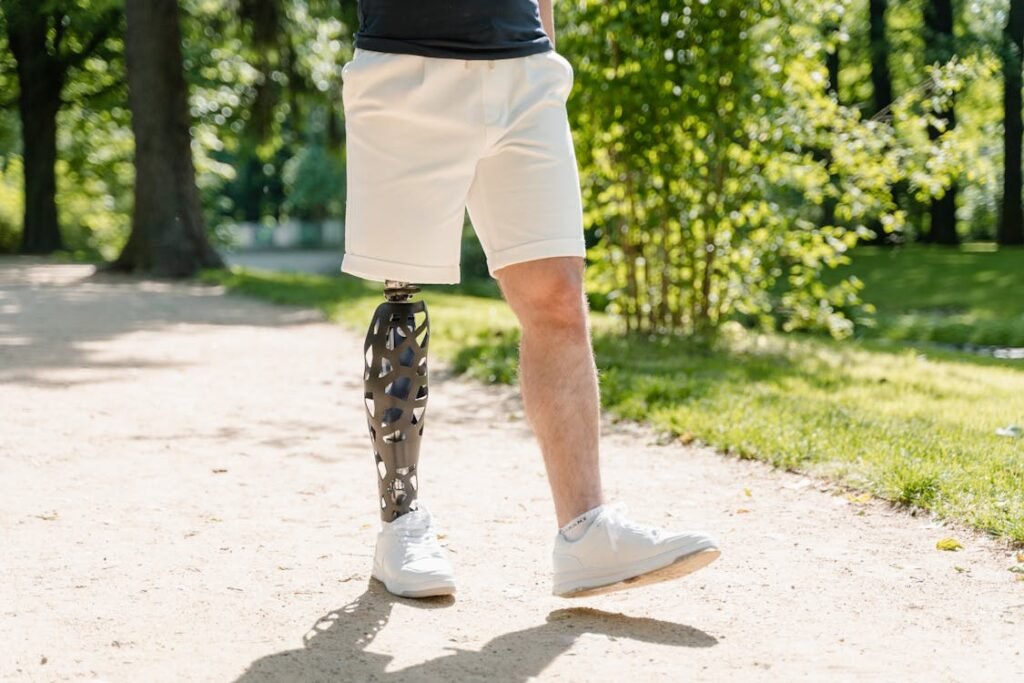
Economic and Occupational Impact of Delayed Prosthetic Fitting
Loss of Employment Opportunities Due to Gait Issues
When a prosthetic is fitted late and gait problems develop, returning to work becomes harder. Many jobs—especially those that require standing, walking, or even basic commuting—demand functional mobility. A person who walks with a limp, tires quickly, or feels unstable on stairs may hesitate to return to employment. Employers, too, may view them as a liability if accommodations are not clearly defined.
This leads to financial stress, which can delay recovery further. Without income, it’s harder to pay for advanced prosthetics, physiotherapy, or travel to medical appointments. It becomes a cycle—delay leads to impairment, which leads to unemployment, which delays care even more.
Widening the Gap for Low-Income Amputees
In India and similar countries, lower-income individuals are already at risk of being underserved after amputation. If prosthetic fitting is delayed for financial or systemic reasons, they often never recover fully. Their gait deteriorates, making them appear more disabled than they truly are.
This affects how they’re treated by society, by employers, and even by their own families. It reinforces negative stereotypes and reduces opportunities for personal growth. Timely prosthetic care could help break this cycle, giving them the chance to stand tall and move confidently in both literal and social terms.
Delayed Prosthesis in Bilateral Amputees: Double the Impact
Coordination and Balance Become Twice as Hard
While most discussions focus on single-limb amputees, people with bilateral amputations (both legs or both arms) face even more devastating outcomes from delayed prosthetic fitting. Their entire mobility system is disrupted. When fitting is delayed, their sense of balance, spatial awareness, and muscle control deteriorate at twice the speed.
In these cases, gait training requires symmetrical movement on both sides. If one or both limbs are delayed in prosthetic integration, uneven compensation patterns develop. Even the smallest misalignment or delay in training can permanently damage the user’s ability to walk smoothly.
Cognitive Load Increases Exponentially
Walking becomes a mentally exhausting task for bilateral amputees, especially if their prosthetic use is delayed. Every movement requires conscious effort—“Am I balanced? Will I fall? Should I move now?” This mental load increases fatigue, lowers walking speed, and creates tension throughout the body.
The result is a slow, unnatural, and sometimes robotic gait that’s difficult to unlearn later. But when both prosthetics are fitted early, patients learn to coordinate movement naturally, often with incredible success and independence.
Cultural Stigma and Gait Perception in Indian Society
When Walking Style Affects Social Acceptance
In India, walking is not just a function—it’s a form of identity. How someone carries themselves affects how others see them. A confident stride earns respect. A limp or visible instability, however, may trigger unwarranted pity or worse—judgment.
When prosthetic fitting is delayed and gait issues become visible, people often face social stigma. Neighbors may whisper. Strangers may stare. Employers might assume incompetence. These micro-rejections damage self-worth and discourage further mobility efforts.
Early prosthetic fitting allows for smoother, more confident walking. It helps the person blend in, not because they’re hiding a disability—but because they’ve mastered it.
How Shame Prevents Seeking Help
In many Indian families, especially in rural areas, physical disability is still seen as a weakness. This can lead to internalized shame. Instead of actively pursuing prosthetic fitting, individuals may withdraw or delay care to avoid being labeled as “burdened.”
Delayed gait recovery reinforces this label, leading to a lack of independence. But when prosthetic fitting happens early and visibly improves movement, it changes the narrative—disability becomes ability. And shame is replaced with pride.
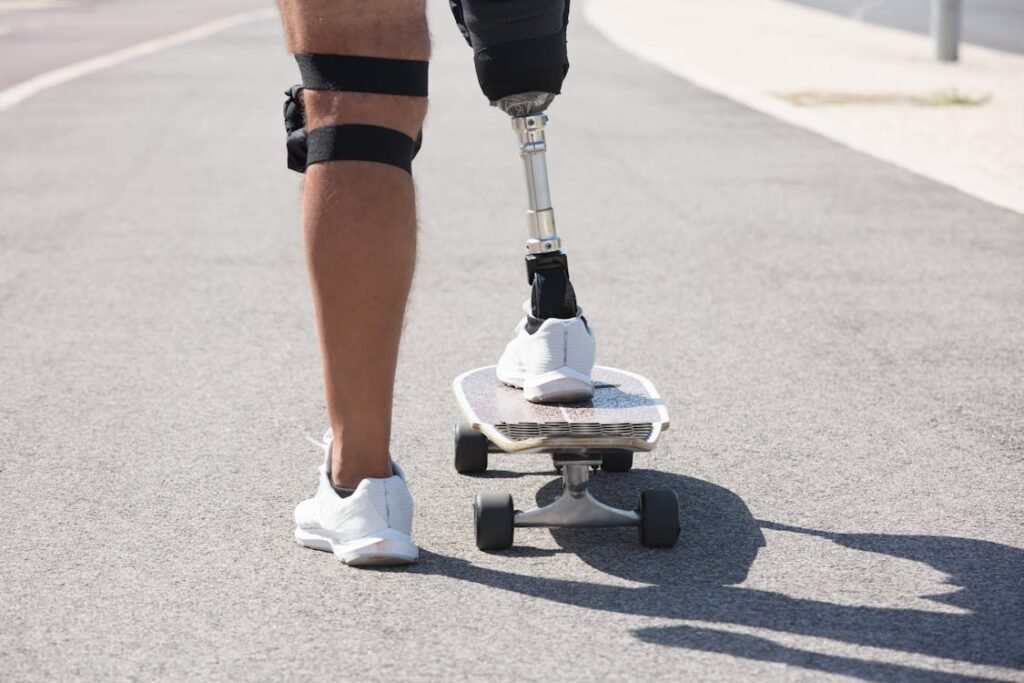
How Delayed Prosthetic Use Affects the Brain’s Motor Map
Your Brain Remembers How to Walk—Until It Doesn’t
Walking is something we learn very early in life, and the brain stores this skill in a kind of internal blueprint. This motor map tells your body how long to take a step, how to balance, and when to shift your weight. But after amputation, this map is disrupted.
If a prosthetic is fitted early, the brain quickly adjusts the old map to include the new limb. But when fitting is delayed, the brain starts rewriting the map in unhealthy ways.
It may “forget” how to walk symmetrically or misjudge the timing of steps. These altered patterns get reinforced the longer the delay lasts.
By the time the prosthetic is finally fitted, the user has to unlearn the faulty map before learning the right one. This makes gait training harder, slower, and more frustrating.
Neuroplasticity Works Best Early
The brain is most adaptable right after a major change like amputation. This period—often called the “golden window”—is when neuroplasticity is at its peak. That means it’s easier to learn, correct, and reinforce new movement patterns.
Delayed prosthetic use misses this window. The brain becomes more resistant to change. Habits become cemented. And every correction takes double the effort.
Early prosthetic fitting, paired with rehabilitation, allows the brain to rewire quickly—laying down a clean, strong motor pathway for a natural gait.
Influence of Delays on Energy Efficiency and Fatigue
Why Walking Without a Prosthetic Drains the Body
When people walk using crutches or hop on one leg, they use more energy. The body must work harder to stay upright, balance, and move forward.
Studies show that amputees without prosthetics expend up to 50% more energy per step. Over a full day, that leads to extreme fatigue, aches, and reduced motivation to stay active.
Fatigue then feeds into gait dysfunction. The person starts dragging their foot, leaning forward, or shortening their steps—not because they don’t know how to walk, but because they’re too tired to do it right.
Early prosthetic fitting helps redistribute the energy load. It lets the prosthetic limb do its share of the work. Walking becomes less tiring, and the person can move for longer periods without strain.
Fatigue Builds Bad Habits
When every step is exhausting, people find shortcuts. They skip steps. They swing their hips unnaturally. They look down at the ground while walking to stay cautious. These shortcuts become habits that degrade gait quality over time.
Once the prosthetic is fitted, these patterns stick around—and must be painstakingly retrained out. But if the prosthetic comes early, before fatigue-based habits form, the person is more likely to develop an efficient, sustainable walking style from the start.
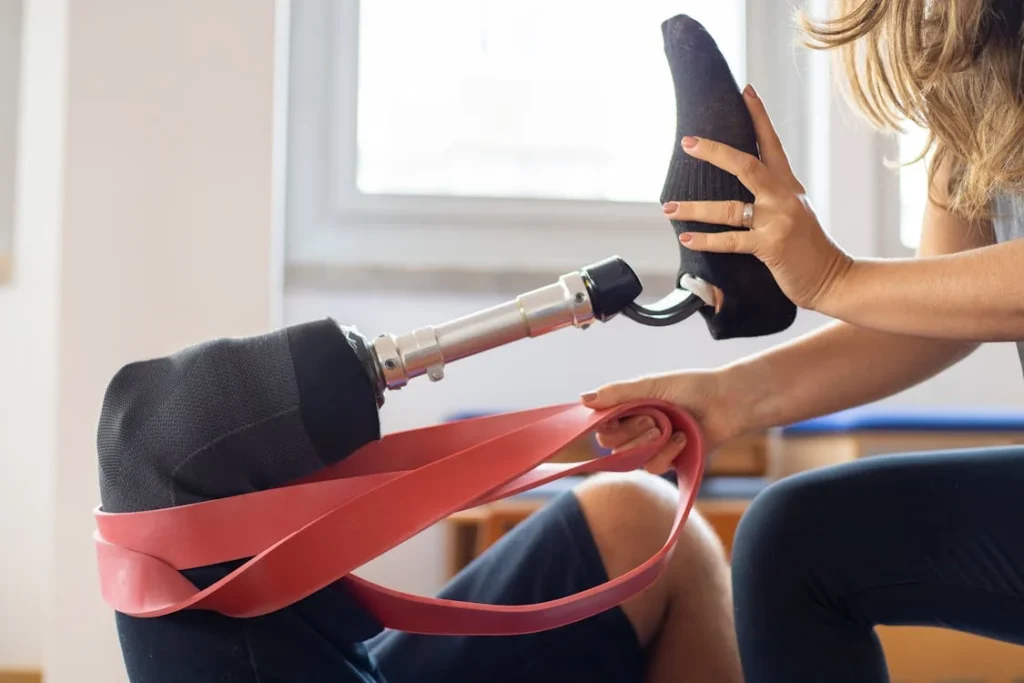
Why Rehab Facilities Must Evolve to Prevent Gait Issues
Lack of Access Delays Fitting in the First Place
In many parts of India, even cities like Noida or Lucknow, prosthetic and rehab services are either limited, underfunded, or too far for patients to reach. Delays often happen not due to lack of awareness, but lack of infrastructure.
This is especially problematic for rural amputees, who may not know when or how to begin the prosthetic journey. They often wait for months, relying on local clinics or informal care that doesn’t prioritize mobility or gait retraining.
Prosthetics manufacturers and hospitals need to form stronger partnerships to bring mobile prosthetic camps, early screening, and fitment centers closer to where people live.
One-Stop Prosthetic Pathways Can Change Everything
Currently, the process of getting a prosthetic in India involves multiple steps: surgical healing, follow-up appointments, referrals to prosthetists, socket design, trials, physical therapy, gait retraining—and much of this is uncoordinated.
What if the process was streamlined? Imagine if every amputee left the hospital with a clear, time-bound prosthetic plan—like a roadmap. Timelines for temporary fitting, therapy sessions, psychological support, and gait milestones would be laid out upfront.
This kind of clarity could prevent delays and drastically improve gait outcomes nationwide.
Conclusion
When it comes to prosthetic fitting, time isn’t just a number—it’s a critical part of your recovery. The earlier you begin, the smoother your journey toward mobility. Delays, on the other hand, open the door to a host of long-term gait issues that can make life harder and more painful.
From muscle weakness and joint stiffness to poor posture and emotional struggles, the effects of delayed fitting are wide-reaching. But the good news is that these problems are preventable.
At Robobionics, we believe in timely action, smart planning, and supporting you every step of the way. If you or someone you know is facing amputation or waiting for a prosthetic, don’t wait any longer. Talk to a prosthetist, start therapy, and take the first steps toward walking freely again.
Your future doesn’t have to be delayed—start walking toward it today.



